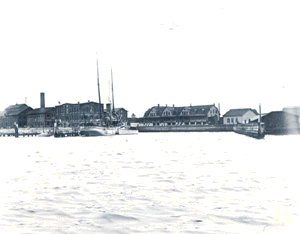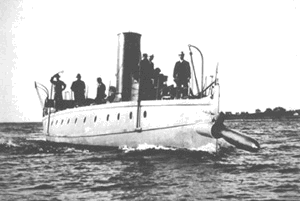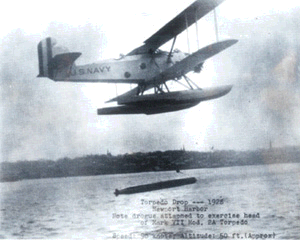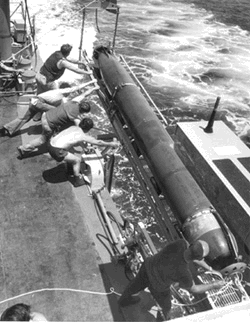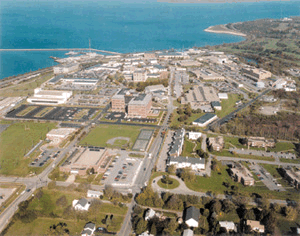| NEWPORT
AND NAVY TORPEDOES - AN ENDURING LEGACY by Mary Anne Cowell and Edward C. Whitman |
||||||||||
Naval Torpedo Station - the Early Years The fact that no fewer than 28 ships on both sides of the conflict were lost to mines and "torpedoes" in the Civil War alerted the Navy to the promise – and the threat – of these new weapons. Thus, even before the war had ended, plans were afoot to create an experimental station for developing the technology of torpedoes, mines, explosives, and electrical devices for naval warfare. In July 1869, the Secretary of the Navy announced the establishment of the Naval Torpedo Station on Goat Island in the harbor of Newport, Rhode Island, and ever since, Newport has been the Navy’s principal center for the design and development of torpedoes. The spar torpedo that Cushing used to sink Albemarle saw use in several contemporary navies but suffered the disadvantage of requiring its operators to close their intended victim to within a spar’s length to set the explosive. Thus, unless a stealthy approach could be achieved, chances of success were slim. The idea of using a self-propelled vehicle to carry the charge to an enemy at some distance followed quite directly. Its first successful implementation was the work of an Englishman, Robert Whitehead, who managed an iron works in Fiume, an Austro-Hungarian port city at the head of the Adriatic Sea. In 1866, he produced the first working "automobile torpedo," powered by compressed air and capable of carrying an 18-pound dynamite charge for 700 yards at six knots. Just before the turn of the century, an Austrian, M. Ludwig Obry, adapted the gyroscope to the torpedo for directional control, and in a series of improved versions, the Whitehead torpedo was quickly adopted by navies worldwide for use on small, fast "torpedo boats" intended for attacking capital ships.
By 1871, the Naval Torpedo Station at Newport had developed its own version of Whitehead’s weapon, the 17-foot long "Fish," and was experimenting with a series of other alternatives, including the Howell Automobile Torpedo, which in 1889 became the first self-propelled weapon issued to the Fleet. For propulsion, the Howell used the energy stored in a 130-pound flywheel spun up to 10,000 rpm just before launching, and it could travel at 25 knots for 400-700 yards. Meanwhile, designers in both Europe and America were competing to field a practical submarine, and by the 1880s about fifteen had actually been built. From the beginning, it was clear that the submarine and the torpedo were made for each other, and indeed, when the U.S. Navy took delivery of USS Holland (SS-1) in 1900, she came equipped with five 18-inch Whitehead torpedoes. The Turn of the Century and the Test of Two World Wars
At about that same time, Vickers, Ltd. in England, who had licensed Whitehead’s patents, revolutionized torpedo propulsion by devising an alcohol-burning "steam" torpedo powered by a small turbine. This innovation yielded higher speeds and much longer ranges, and in 1907, the U.S. Navy built a factory at the Torpedo Station specifically to produce an American version of the British weapon. Adding their own improvements – notably injecting water into the combustion chamber for more steam – U.S. engineers scaled the resulting "Bliss-Leavitt" torpedo up to 21-inch diameter to yield a weapon that could travel at 36 knots to a range of 3,500 yards. This was designated the Torpedo Mark 10, and over 1,000 were manufactured for use in World War I. The Naval TorpedoStation, which expanded its industrial capacity dramatically for the war, also played a key role in developing underwater explosives, depth bombs, and mines for the anti-U-boat campaign.
Between the wars, despite severely constrained resources, Newport developed a variety of common torpedo components, including exploder, propulsion, and control systems, to reduce cost and facilitate production and training. With the Navy’s introduction of their first torpedo planes in the 1920s, the Station also turned to developing air-launched weapons, initially by modifying existing torpedoes for dropping from aircraft. At the same time, the Station acquired a larger facility on Gould Island in Narragansett Bay, at first for proof-firing both air-dropped and tube-launched weapons, but later for re-working them as well. By the outbreak of World War II, these efforts had culminated in Navy acceptance of the Torpedoes Mark 13, 14, and 15, as the standard weapons for aircraft, submarines, and destroyers, respectively. Then, in the build-up that preceded the conflict and during the war itself, over 10,000 employees produced upwards of 18,000 torpedoes on site and proof-tested additional numbers manu-factured at the torpedo factory in Alexandria, Virginia. All told, there were over 75,000 proofing tests on the Station’s ranges during that era. Unfortunately, this proof testing was not thorough enough to reveal serious torpedo design deficiencies that emerged early in the Pacific War, particularly in the Mark 14 submarine weapon. Grave suspicion about torpedo performance began to emerge among submarine commanders in the first months of 1942, the result of failed attacks on enemy ships from deep running, premature detonations, and frequent dud hits. The Navy’s technical community – and some flag officers – were slow to appreciate the seriousness of the problem, preferring instead to blame operator error for the growing number of frustrated attacks. Only when the submarine authorities in Pearl Harbor undertook their own series of improvised experiments, beginning in June 1942 and lasting over a year, was it proven that a combination of independent design faults had undermined the performance of our torpedoes – and hence that of our submarines – since the beginning of the war. These problems included inadequate depth control, a hypersensitive magnetic influence exploder, and deficiencies in the contact exploder mechanism. All had remained undetected in the lean years of the 1930s when in-water developmental and operational testing was held to a minimum. Fortunately, when the truth became known, the torpedo community quickly devised corrections and implemented them in both the stockpile and new production, but the bitter lessons learned still reverberate today. Even before the war, alternatives to Bliss-Leavitt "steam" propulsion had emerged, and several of these were investigated at Newport. With advances in battery technology, electric torpedoes had been feasible since the 1920s, but although several variants were built and tested, only the Mark 18, manufactured by Westinghouse, saw significant use by the United States in World War II. New, higher-energy torpedo propellants were also studied, because of the great increases they offered in speed and range. Most important of these were the so-called "oxygen" systems that used the decomposition of concentrated hydrogen peroxide to generate an oxidant for the primary fuel. This approach was adopted successfully by the Japanese before the war for both submarine and surface-ship torpedoes, among the latter, the infamous 24" "Long Lance," which emerged as the most effective destroyer torpedo of the conflict. However, because of concern about the dangerous volatility of the associated fuels and oxidizers, the U.S. Navy delayed its acceptance of this approach until the early years of the Cold War, when variants were adopted for the Torpedoes Mark 46 and Mark 48. Another major innovation accelerated by the war was that of acoustic homing torpedoes, beginning with the Mk 24 mine-torpedo, "Fido," devised in collaboration by the Harvard Underwater Sound Laboratory and American industry. The Post-War Era The Cold War and the McNamara defense reforms saw a shift in the role of in-house Navy activities from weapons production to research and development (R&D), with heavier dependence on private industry for the former function. Thus, in 1951, after over 80 years in existence, the Naval Torpedo Station transitioned from an industrial activity to a full-time R&D center, changed its name to the Naval Underwater Ordnance Station (NUOS), and moved two miles north on Narragansett Bay to Coddington Cove, the site it still occupies today. At the same time, its mission was expanded to embrace weapon launchers and underwater fire control systems for both submarines and surface ships. Shortly thereafter, NUOS assumed a key role in the development of the wire-guided, electrically-driven acoustic homing torpedo, Mark 37, which reached the Fleet in 1956 and then embarked on a technology program to prepare the ground for a new generation of heavyweight submarine torpedoes responsive to the growing Soviet threat. New high-energy-density propulsion systems and more sophisticated acoustic homing technologies were explored, and Newport later collaborated with Clevite-Gould and Westinghouse on the engineering develop-ment and fleet introduction of the resulting Torpedo Mark 48 in the early 1970s. Later, they also managed the development of the Mark 48 Advanced Capability (ADCAP) torpedo that appeared subsequently in 1989. Both of these use Otto fuel, a chemical monopropellant that contains its own oxidizer. In the aftermath of realigning Navy R&D center responsibilities in the early 1990s, the Newport complex – by now renamed the Naval Underwater Weapons Research and Engineering Station (NUWRES) – inherited technical responsibility for air-dropped and surface-launched lightweight torpedoes from the former Naval Ocean Systems Center in San Diego, California. These included the battery-powered Torpedo Mark 44, first introduced in 1956, and its widely-deployed successor, the Torpedo Mark 46, which first appeared in 1963 using solid chemical fuel, but then modified in 1967 to employ liquid monopropellant. Subsequently, the facility collaborated with Honeywell/Alliant Tech in developing the Torpedo Mark 50 – formerly the Advanced Lightweight Torpedo – which was fielded in limited numbers in 1994 employing a Stored Chemical Energy Propulsion System (SCEPS) based on a lithium-flourine reaction to achieve high speed and deep diving capability. Presently, the best of both Mark 48 ADCAP and Mark 50 technology is being exploited to develop a new and affordable Mark 54 Lightweight Hybrid Torpedo optimized for shallow-water operations.
During an earlier Navy laboratory reorganization in the 1970s, the Navy Underwater Sound Laboratory, New London, Connecticut, had been joined with NUWRES to become the Naval Underwater Systems Center (NUSC), with broad responsibilities across the entire spectrum of undersea warfare. Finally, in 1992, the Systems Center was teamed with the Naval Underwater Weapons Engineering Station, Keyport, Washington, to form today’s Naval Undersea Warfare Center (NUWC), headquartered in Newport. Today, the Center is active in research, development, and in-service engineering for torpedoes and other tactical submarine-launched weapons, ASW mobile targets, countermeasures, unmanned underwater vehicles (UUVs), sonar and underwater fire control, and a wide range of submarine auxiliary components, such as periscopes and antennas. Today, Goat Island is the site of a modern luxury hotel off fashionable downtown Newport, and on Gould Island, only the fragmented remains of the old industrial complex remain to evoke the shadows of the past. But every day at Coddington Cove, NUWC employees are researching new technologies, developing new undersea systems for the Fleet of the 21st century, and looking for another 130 years of achievement on the shores of Narragansett Bay. Mary Anne Cowell is a technical writer in the Enterprise Development Group, Naval Underwater Systems Center, Newport Division. Dr. Whitman is a technical director at Anteon Corporation’s Center for Security Strategies and Operations in Arlington, Virginia. |
||||||||||
nexst to torpedotubes |
